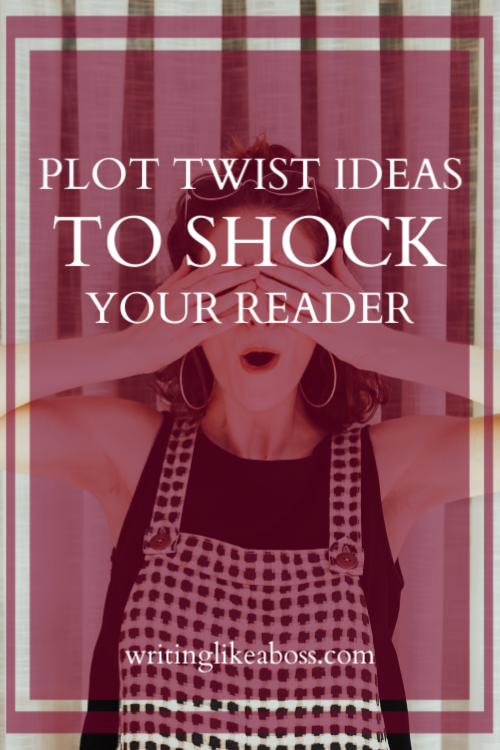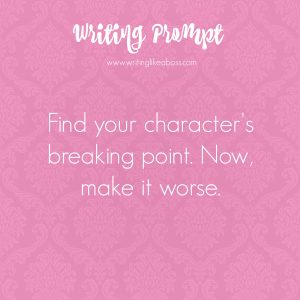Plot twists, done well, are a superb addition to the suspense in your story. Which is why I’ve compiled this list!
Not everything in this post is necessarily a “plot twist” – some of them can just be referenced during your “Well, now what?” moments. Which is why I’ve sorted them from most to least drastic, so you can find just the right “twist” for your story.
Without further ado:

Plot Twist Ideas to Shock Your Reader
Start a war or revolution. I like this one because it could work for just about any genre: dystopian, historical, fantasy, science fiction, adventure … the list goes on. I wrote a fantasy novel from the POV of dragons last year, and the only reason I kept going with the story was because I had an unlikely character inadvertently start a war. It gives you so much more material for the rest of the story!
Kill someone off. This is about as drastic as it gets! But it certainly is effective; especially for fantasy, dystopian, sci-fi, or adventure writers. Tip: the more time the reader has to bond with the character, the sadder the death will be!
Almost kill someone off. Give one of your characters a near-death experience. Maybe s/he falls fatally ill and they don’t know what caused it, and maybe they learn in the worst way that the disease is contagious. Perhaps s/he’s closest companion falls from a great height – off a roof or a cliff, maybe – and they don’t know whether he survived or not. Explore some ideas!
Your protagonist develops a fatal illness. Will s/he live? Will s/he die?
A hurricane sweeps the nation. What do your main characters do? How does the natural disaster affect the mission?
Your protagonist has to assume a secret identity. Does s/he do it to protect themselves, or others? What is their secret identity? How far will s/he go to maintain it?
Reveal (or hint at) a traitor. Who’s been secretly giving information to the bad guy? The best friend? The lover? The parent? Bonus points if the POV character is close to the traitor. Extra-bonus points if he was only betraying them to protect them. Oooh, here’s another one: is the POV character the traitor?!
The parents are working for the antagonist. This works well if your protagonist is particularly close to their parents.
Take away the object crucial to their success. Did they lose the map? Or did the magical way-finding whatsit get stolen? Are your characters starting to blame each other for the loss?
A character disappears in the night. Or in the day. Y’know, whatever you put in your tea.
Whenever possible, apply Murphy’s Law: “Anything that can go wrong, will go wrong.” So basically, imagine the worse possible thing that could happen to your characters, and go from there. For extra punch: make it even worse than the worst.
Your protagonist quits their mission. Why did s/he quit? Will s/he come back to the mission?

Swap your characters’ personalities. I know, this trope is becoming a cliché. But it really does add an engaging humor element to a sci-fi story, if you’re willing to take the risk! Tip: try twisting the cliché in some other direction!
Have your character wake up … but something is different. Is your MC’s hair suddenly a different color? Is there a stain on the bathroom carpet? Is something dear to your character missing? Is there a long, silvery crack in the window that wasn’t there before? Has the sun disappeared?
Give one of your characters a secret. This is so simple it’s almost unbelievable. A character secret is basically a “life-hack” for reader engagement, character development, and plot advancement.* Is a secondary character secretly working for/friends with the bad guy? Is the MC hiding something deep and scary from everyone (even the reader)? Is someone close to the MC acting funny? Tip: Don’t reveal the secret right off the bat. Leave the reader wondering, but not too long! If you drag it out too far, your reader will lose interest.
(*… plot advancement. I originally wrote “plot forward-ness,” and I came so close to keeping it that way. I settled with a footnote instead. Wait, is it still a footnote if it’s in the middle of the page? I wonder about these things.)
Introduce some kind of blackmail. What secret information about your MC does the other character – friend or foe – possess? Or is your MC blackmailing someone else? Are they being forced to do it, or was it their own choice? What if there is an entire chain of blackmail?
Make a character ill. This one is expendable, so you can customize it to whatever your story needs. If you’re stuck in a scene, you can give your character a cold, flu, or a night of getting sick; but if you need something more intense and exciting, give them a more drastic disease, a chronic disease, or a even mental illness.
Two unlikely characters share an unexpected kiss. Who are they? Why did they kiss?
An animal delivers a message. Is the message frightening, or is it a love letter? Who is it from?
Embarrass your POV character. This is a light, not-so-drastic solution to the “now what?” issue. Was something private shared with the rest of the world? Did the character do something wrong and now everything has gone awry? Your reader will sympathize with her/him almost automatically. Tip: if you can’t relate, neither will the reader!
Embarrass your secondary character(s). Does your MC feels bad for her/him? Or was your MC the cause of the embarrassment?
I may add more later on, so please come back soon! 🙂
Let’s talk! Questions? Additional ideas? Let’s talk below!


Comments
4 responses to “Plot Twist Ideas to Shock Your Reader”
Sam, after conquering writers block once, I had reached it again. That is, until, I read this wonderful idea jerking blog post! Now I know exactly what I’m going to do and it should push me forward for quite a while. And then when I’m stuck again, I’ll find just the right blog post you’ve posted, and continue from there so on and so on until my book is finished! Thank you for your brilliance!
Aw, I’m so happy you found it helpful!! That means a lot to me. 🙂 Writers block stinks, but I’m glad you’ve overcome it. Thanks so much for your feedback!
Hey there! I stumbled across your blog while browsing Pinterest. This post is extremely helpful, but I’m really struggling with developing a plot with substance. I know some stuff that I want to have happen, and how I want it to end, but I don’t know what else to write (for the beginning and middle, etc). Do you have any tips? Thanks!
Hello, J! I am so glad you’ve found my blog. 🙂 To be completely honest, plot is something I struggle with, too. I feel like it’s the only topic I HAVEN’T written. But I have some quotes from a book I’m reading (“A Novel Idea”), which should hopefully help. I seriously recommend buying it, so you can read the “Plot” chapter in its entirety:
(This whole section was written by Gail Gaymer Martin.)
“The plot is the journey. Pacing is the rate at which problems affect the journey. Think of climbing into a canoe and heading down an unfamiliar river (the journey). The river holds unexpected hazards and dangers (the problems). Between occasional calm stretches of water, the canoe encounters tree branches, rocks, the difficult flow of a whirlpool, the current caused by a towering boulder, and dangerous white water. When the destination is within reach, a waterfall roars ahead of the canoe. . . . One small bypass appears to reach dry land, and the final battle begins.
“Good plotting includes:
— A strong need or goal that can change or destroy the character or his purpose.
— Powerful opposition – either external or internal – that deepens conflict.
— A compelling situation or duty that binds characters in their struggle.
— More than one possible solution to a character’s dilemma, forcing a choice.
— Effective backstory used on a need-to-know basis.”
The author also writes paragraphs about including subplots, secrets, interrupted scenes, and evolving motivation in your plots; as well as raising the stakes, asking “what if,” adding/removing a character, and creating “impossible situations.” Happy writing!